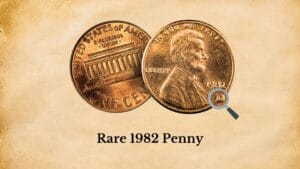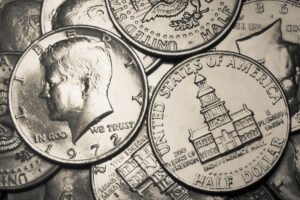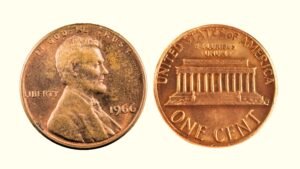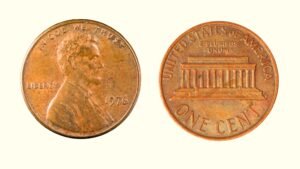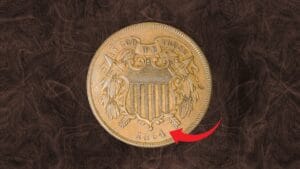Coin dealers & coin collectors love the 1982 pennies for their history, material variations, and high-relief motifs that pay tribute to Abraham Lincoln, the 16th U.S. President.
But since these have about 16 billion pieces in circulation, finding one worth more than its face value is difficult! In fact, only the uncirculated or 95% copper coins cost more, up to $100. Identifying such valuable 1982 pennies can be tricky, but not with this 1982 Penny value guide! So, let’s jump into it!
Key Takeaways
- 1982 pennies have a high mintage of 16 billion plus coins! So, it’s only the rare & graded MS 65 & 65+ coins that are worth the money.
- A small date, 1982 D Penny in mint state with 68 grade, can cost up to $2,000 in mint state.
- Old 1982 pennies have two compositions: Bronze (88% Copper & 12% tin) or Zinc, of which the copper ones cost more due to their resale value.
- Among the five types of errors in old 1982 pennies, coins with a d-mint double die or double ear error are the most precious.
The Historical Journey of the 1982 Lincoln Penny
The 1982 penny had a bumpy historical ride, partly due to its materials, inflation, and government policies as follows:
- 1909 – 1970: The United States Congress minted a new set of 1-cent coins, called the Lincoln penny, each with a core of 95% copper. But as people began hoarding and reselling it, the mint switched to aluminum coins in 1973.
- 1974: Vending machine operators stopped using corrosive aluminum pennies, and thus, Congress had to amend the penny’s composition. Later, they finalized bronze – an alloy of 88% copper & 12% tin.
- Early 1982: Most of the existing copper was deployed to troops and ammunition during the war. So, the mints had to revise the penny’s composition again! This time, they used 97.5% zinc and 2.5% copper.
- August 1982: Congress started minting the pennies at two more locations – Philadelphia (no-mint) and Denver (d-mint). And later, in October, they initiated a mini-penny facility in San Francisco that minted 3-million+ proof coins.
| 1982 Lincoln Penny | Key Features & Facts |
| Material Composition | Bronze (88% Copper & 12% Tin) or Zinc Alloy (97.5% zinc & 2.5% copper) |
| Minting Location | Philadelphia, Denver |
| Minting Year | 1982 |
| Face Value | 1-cent ($0.01) |
| Weight | 3.11 grams (Copper) or 2.5 grams (Zinc) |
| Diameter | 19 mm |
| Thickness | 1.55mm |
| Designer | Victor D. Brenner (Obverse)Frank Gasparro (Reverse) |
| Mint Marks | ‘D’ for Denver, ‘S’ for San Francisco proof coins No mint mark for Philadelphia |
| Total Mintage | 16,725,504,368 |
Design Features of the 1982 Copper Penny
Designed by two official mint engravers of the US Congress, the 1982 penny, an adaption of the official Lincoln penny, portrays the following memento features:
1. Obverse (Front) Design:
You can identify a 1982 Penny Obverse (designed by Victor D. Brenner) with the help of the following features:
- A bas-relief, right portrait of Abraham Lincoln, the 16th President of the States
- The minting year ‘1982’ inscribed on the lower right side
- The phrase ‘IN GOD WE TRUST’ engraved above Lincoln’s head along the upper rim
- The word ‘LIBERTY’ is written on the left side, in compact kerning

2. Reverse Design:
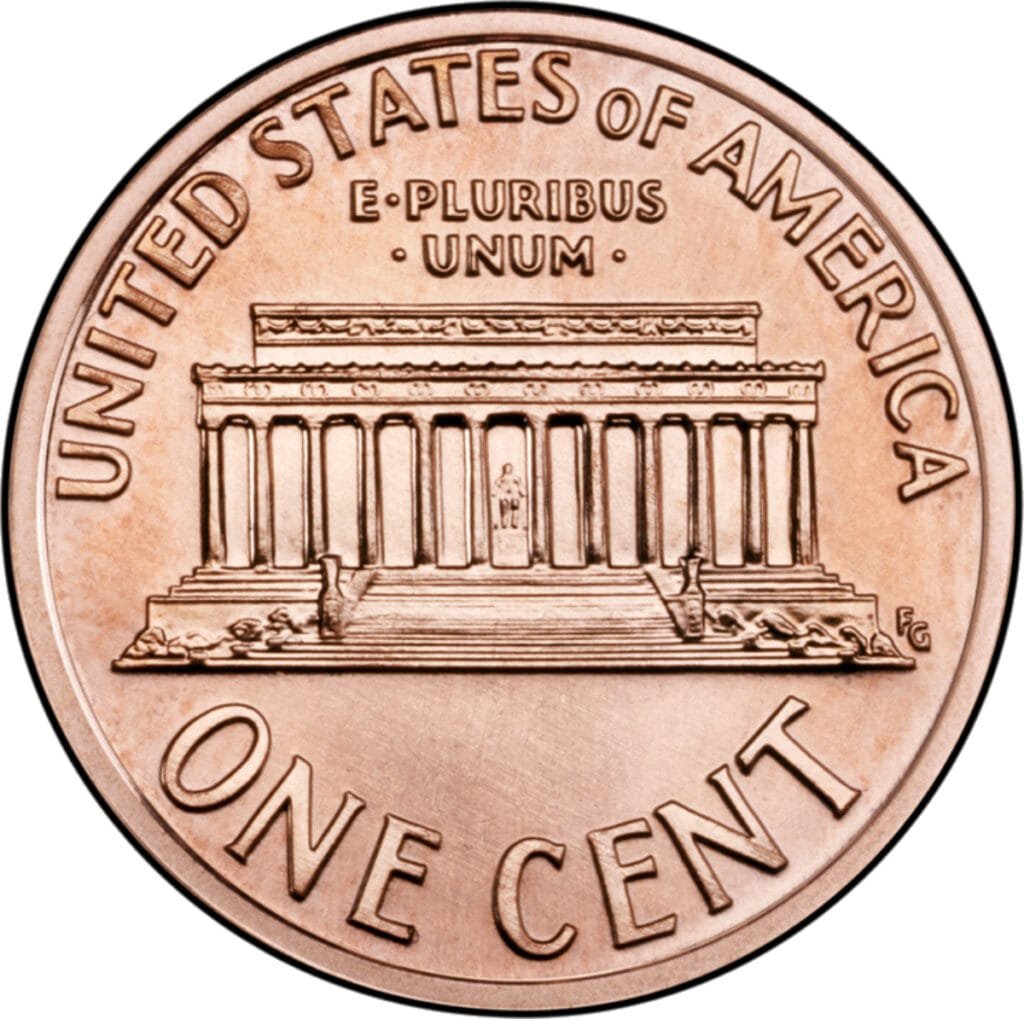
Conceptualized by Frank Gasparro, the 1982 Penny’s reverse (tails) has the following key traits:
- A carved Lincoln Memorial (Washington, DC) at the center with 12 columns, steps, and plinth
- The national US motto, ‘E PLURIBUS UNUM,’ inscribed above the hall
- The nation’s name ‘UNITED STATES OF AMERICA’ engraved along the upper edge
- The face value, ‘ONE CENT,’ written along the bottom rim in bold font
3. Coin Composition & Measurements:

Despite having the same diameter of 19mm and thickness of 1.55 mm, the 1982 pennies have a different coin weight. That’s because Congress changed the coin composition and converted the pure copper pennies to 97.5% zinc pennies during inflation.
So, if your coin has an even, chocolate brown or orange hue, it might be an old, 88% copper & 12% tin penny, weighing over 3.11 grams, with a resale value of $0.02.
But, if it has uneven or spotted toning, it might be a copper-clad, 97.5% zinc coin weighing 2.5 grams. Also, all these coins have a plain edge, with no raised motifs or borders.
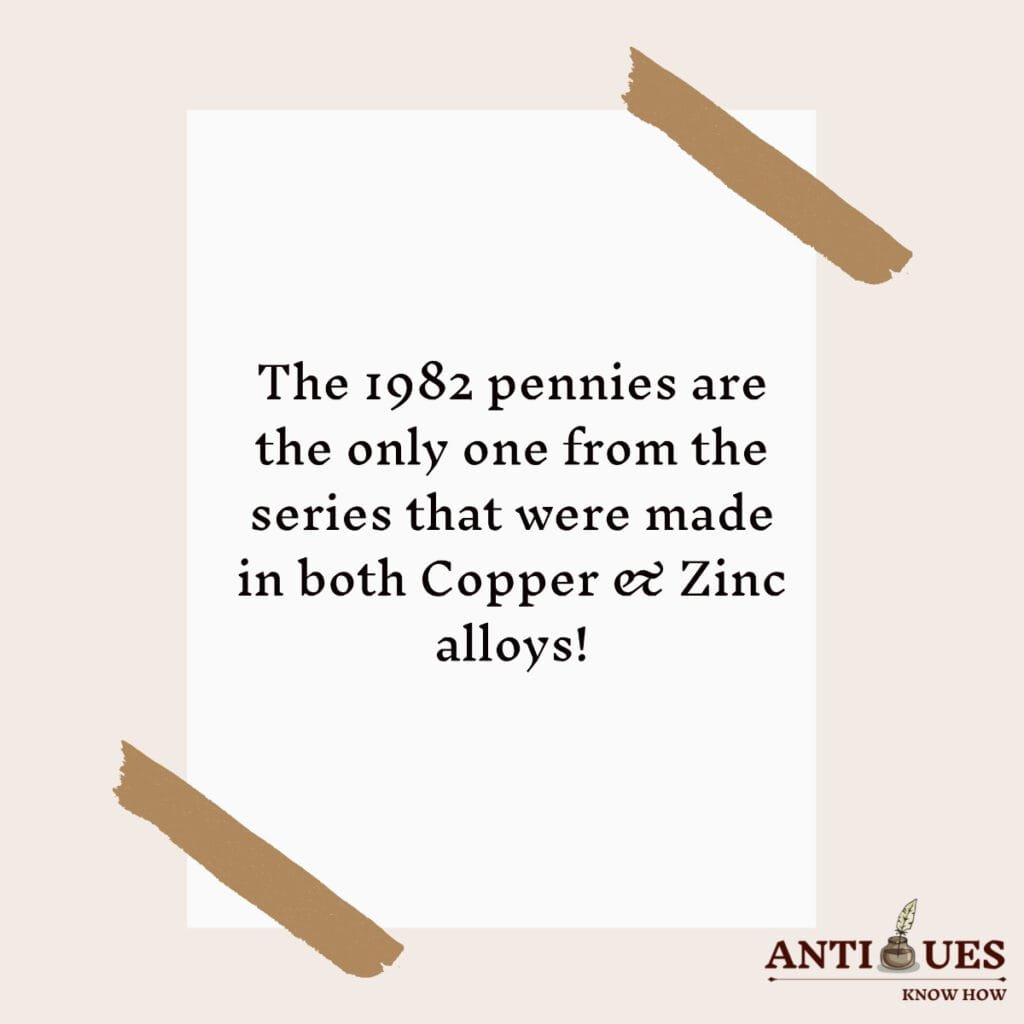
4. 1982 Penny Variations:
The 1982 pennies have the following variations based on their font size and die:
- Small Date: The small date copper penny variation of the 1982 cents can be spotted by their small and thin mint date font, delicate numbers, and wider gaps. Limited to about 10 million coins, these pennies fetch about $2,500 for used, 88% copper coins, and up to $2,000 for zinc ones.
- Large Date: You can identify a 1982 large date penny by its thick, bold, and blunt letters with tight kerning. Today, these value about $1,600 for copper pennies and up to $1,000 for the zinc ones.
Here are a few more differences:
| Key Feature | Small Date Variation | Large Date Variation |
| Date Alignment | All the numbers in the mint date are aligned | The numbers 8 & 9 are higher than the 1 & 2 |
| Number Alignment | The ‘2’ in ‘1982’ is slightly inclined to the right | All the numbers are straight and evenly spaced |
| Spacing | There’s a clear 2mm gap between the upper rim and the motto on the obverse | The motto ‘IN GOD WE TRUST’ touches the upper rim |
5. Unique Mint Marks & Identifiers:
- 1982 No Mint Mark Penny: All the 10,712,525,000 (10 billion) pennies minted in Philadelphia don’t have any mint marks. So, they are a bit common and cheaper, valuing up to $80, unless in an uncirculated or MS 64+ state.
- 1982 ‘D’ Penny: About 6,012,979,368 (6 billion) D Lincoln pennies were minted in the Denver mint in 1982. And you can identify them by the small ‘D’ mark below the mint date on the obverse.
3 Factors That Affect the Worth of a 1982 Penny
Now let’s understand the three most important factors to spot a valuable penny and appraise it:
1. Condition & Grading
Since the 1982 pennies have a high mintage, they don’t fetch more than their face value, in circulated or poor condition. But if your coin is certified with an MS65+ or uncirculated mint state grade, it might be worth up to a hundred dollars!
So let’s check out an old 1982 penny value, based on detailed research from eBay, Etsy & other auction sites:
1982 Lincoln Memorial Penny | 1982 Penny’s Grade | 1982 Penny (Small Date) | 1982 Penny (Large Date) | ||
| Copper Penny | Zinc Penny | Copper Penny | Zinc Penny | ||
1982 Penny | Average to Good | $1 – 40 | $1 – 5 | $1 – 5 | $1 – 5 |
| Fine (F) to Extremely Fine | $40 – 80 | $10 – 50 | $5 – 60 | $5 – 40 | |
| MS 64 or 65 | $50 – 300 | $40 – 150 | $50 – 170 | $25 – 60 | |
| MS 66 or 67 | $40 – 500 | $20 – 270 | $20 – 150 | $13 – 70 | |
| MS 68 or 69 | $800 – 1,500 | $140 – 800 | $350 – 1,000 | $150 – 400 | |
1982-D Penny | Average to Good | $1 – 20 | $1 – 5 | $1 – 5 | 90 cents – 5 |
| Fine (F) to Extremely Fine | $30 – 200 | $5 – $40 | $5 – 100 | $2 – 50 | |
| MS 66 or 67 | $200 – 700 | $70 – 280 | $140 – 300 | $50 – 200 | |
| MS 68 or more | $1,000 – 2,000 | $100 – 1,000 | $500 – 1,300 | $400 – 1,000 | |
2. The 1982 Penny Proof Coin
In 1982, the national San Francisco Mint produced about 3,857,479 proof coins for collectors. All of them had more shine and a superior S-mint mark that hiked their costs up to $1,600 for a PCGS-approved PR 67 grade.
So, if you want to know if your 1982 penny is a proof coin, check the following features:
- The S-mint mark on the right side of the obverse, below the minting year
- A standard composition of 95% copper & 5% tin
- A high contrast between the background & President Lincoln’s portrait
- Shiny, golden-finished, and raised motifs
- Glass-like luster on the obverse and reverse
3. The 1982 Penny Errors
Unlike the other coins that have simple dual-glare errors, the 1982 Penny has some unique minting errors as follows:
1. A D over D error: This was a common error in the earliest d-mint pennies caused by the double minting of the d-mint mark. So, look for a double, bold, or slightly eccentric d-mark to spot this error. Overall, such double-D coins cost up to $7 today!
2. Double Die Error: If you see a bold or doubly-minted Lincoln’s hall on the coin’s reverse, it might be a double die error. And such faulty coins are a collector’s paradise today, valued up to $1,500.

3. Double Ear Error: This error was common in the d-mint coins minted in the latter half of 1982. The President’s ear was punched twice on the obverse, making it broad and profound. But today, this unique die error can hike your coin’s cost up to $150 in good condition.
4. Off-Center Error: If the President’s portrait isn’t exactly in the center of the obverse, or if there are any big, blank chunks on the outer edges, it might be an off-center error. Remember, the more off-center the design is, the higher the coin value.
5. Gas Bubbles Error: Some of the Denver-mint zinc pennies had the occluded gas bubble error. This meant the planchet was heated unevenly, leaving air pockets and a bubbly surface on the coin. Usually, zinc coins with this error cost up to $50.
How Do I Know if My 1982 Penny is FAKE?
Despite a high mintage, the 1982 penny has many counterfeits regarding its materials, weight & copper cladding. And here’s a list of some of these FAKE features:
- Raised bumps along the pillars of the Lincoln Hall
- Different coin size, weight, and color
- Might make a dull, thud-like sound when tapped
- Glued or embossed motifs and mint marks
- Might have reeded edges
- Visible die lines or mold marks
How Do You Tell if a 1982 Penny is a Small or Large Date?
The fastest way to tell if a 1982 penny has a small date or a large date variation is to check the alignment of its numbers. In a small date variation, all the numbers in the mint date are properly aligned. But, in the large date ones, the ‘8’ and ‘9’ might be higher than the rest.
How Can You Tell If Your 1982 Penny is Copper or Zinc?
Get an electronic coin scale and weigh your coin. If it weighs about 3.1 grams, it might be a 95% copper coin, but if it weighs less than 2.5 grams, it’s a zinc coin.
Despite a high mintage, the 1982 penny is collectible for its unique double-D or off-strike errors, just as a 1943 steel penny! So, use my guide to identify such in-demand anomalies, grades & features of these pennies and ensure you get the right price!
Note: This article is intended for informational, educational, and entertainment purposes only. Some images are illustrative and may not represent actual brands, products, or related entities. All trademarks, product names, brand logos, packaging, and other intellectual property referenced remain the exclusive property of their respective owners. Any brand mentions or references are provided solely for descriptive and educational context and do not imply any formal or commercial association.

